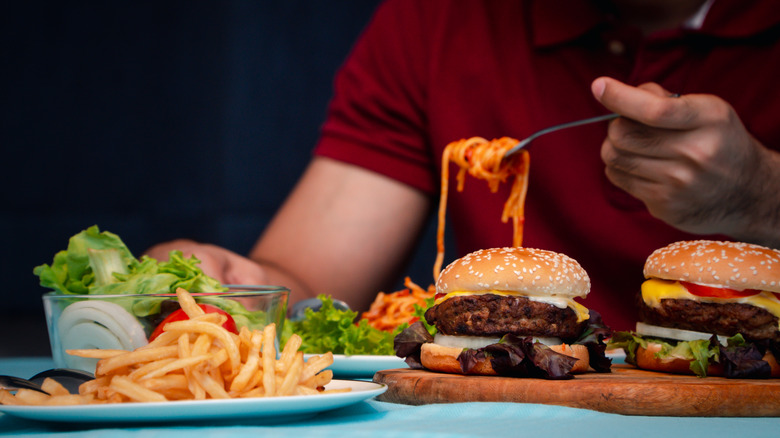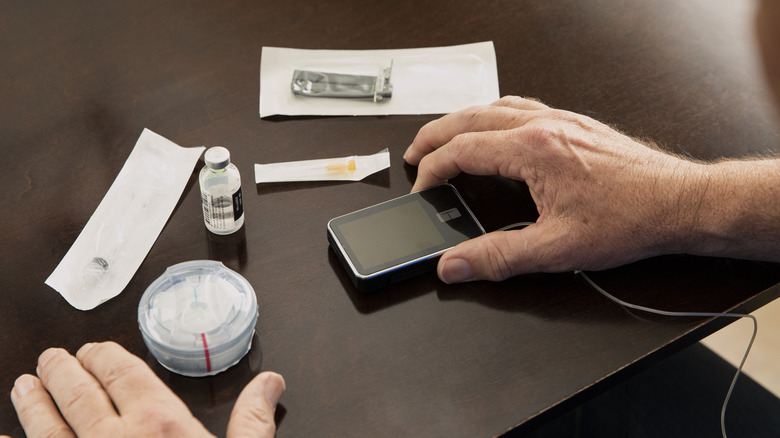Lesser-Known Eating Disorders You Should Know About
According to the National Institute of Mental Health (NIMH), eating disorders are serious illnesses that could be deadly if not treated. Eating disorders are associated with an unhealthy focus on weight, body shape, and food, often leading to malnutrition and affecting health and wellbeing (via Mayo Clinic). The National Eating Disorders Association (NEDA), points out that eating disorders are caused by a mix of biological, psychological, and social factors. Anyone of any race, gender, age, body shape, sexual orientation, or weight can have an eating disorder. These disorders are fairly common as well — an estimated 20 million women and 10 million men in America will have an eating disorder in their lifetime.
The most common eating disorders are anorexia nervosa, bulimia nervosa, and binge eating disorder, according to the NIMH. But there are less common eating disorders that are just as serious (per Monte Nido). For different reasons, some of these eating disorders are not recognized by the Diagnostic and Statistical Manual of Mental Disorders, 5th Edition (DSM-5), a diagnostic tool used by U.S. mental health professionals. However, these disorders are real to those who face them and are being studied by researchers to find better ways to manage them.
If you need help with an eating disorder, or know someone who is, help is available. Visit the National Eating Disorders Association website or contact NEDA's Live Helpline at 1-800-931-2237. You can also receive 24/7 Crisis Support via text (send NEDA to 741-741).
Pica
Pica is an eating disorder where an individual ingests substances that are not food or nutritious, frequently, for at least a month (via NEDA). People with pica crave substances like soil, ice, paper, chalk, soap, starch, paint, or hair, though they will usually eat regular food as well. There are people who eat non-food items for social or cultural reasons, but these people are not considered to have pica. Similarly, children under two years, who usually mouth or ingest different objects, don't have pica.
Pica is more common among children, although anyone can have it (via Family Doctor). It affects 10-30% of children below six, and those with developmental disabilities are at heightened risk of developing the disorder. Occasionally pregnant women develop pica, which can lead to a nutrient deficiency in the baby since eating non-food items can hinder the mother's absorption of nutrients from food (via American Pregnancy Association). Though the exact cause of pica isn't known, the condition could be a sign of deficiencies of nutrients like zinc, calcium, or iron (via Cleveland Clinic).
Pica often leads to gut disturbances like ulcers, bleeding, pain, constipation, or diarrhea (via Family Doctor). It could also cause teeth injuries, blockage of the intestine by hard non-food items, lead poisoning (if paint is ingested), or infections. Pica goes away spontaneously for some people, while others need intervention. Pica treatment involves managing any complications, addressing suspected causes such as nutritional deficiency, and behavioral therapy.
Avoidant restrictive food intake disorder
Avoidant restrictive food intake disorder (ARFID), previously named selective eating disorder, is characterized by extremely picky eating (via Center for Discovery). Those with ARFID either have little interest in eating or food, fear that something bad will happen (like choking) if they eat, or are averse to the taste, texture, or temperature of some foods. This eating disorder is so detrimental that people with it lose weight, have nutrient deficiencies, depend on tube feeding or oral nutritional supplements, grow slowly, or have poor wellbeing (via NEDA).
Not every picky eater has ARFID. According to a study published in the Journal of Eating Disorders, people with ARFID tend to eat from a range of 20 foods or less and have rigid eating standards along with food neophobia (avoidance of new food). They also have more severe obsessive-compulsive symptoms and impaired wellbeing than regular picky eaters.
ARFID mostly affects children, and it's one of the most common eating disorders that children suffer from (via The Recovery Village). Those with an autism spectrum disorder or attention-deficit hyperactivity disorder (ADHD) are at a higher risk for ARFID (per NEDA). Though ARFID can lead to poor health outcomes if left untreated, treatment is possible and most often successful for those who undergo it. People with severe malnutrition are treated with supplements and tube feeding to keep their bodies healthy, while talk therapy is effective for mild ARFID.
Other specified feeding and eating disorders
Other specified feeding and eating disorders (OSFED) are eating disorders that don't meet the full criteria of anorexia nervosa, bulimia nervosa, or binge eating disorder, according to Columbia University. These disorders include atypical anorexia nervosa (this is the diagnosis given to someone who is not underweight but whose symptoms otherwise match those of anorexia), bulimia nervosa of low frequency or duration, binge eating disorder of low frequency or duration, purging disorder (purging without binge eating), and night eating syndrome.
The idea that OSFED doesn't meet the requirements of "true" eating disorders can trivialize the challenges that people who have these disorders face. NEDA states, though, that OSFED is just as severe, but also as treatable, as other eating disorders. However, due to the perception that OSFED is less serious, the Center for Discovery notes that those with OSFED often don't receive the treatment they need. Treatments for OSFED include nutritional counseling, cognitive behavioral therapy, dialectical behavioral therapy, interpersonal psychotherapy, and medications (via The Recovery Village).
Orthorexia
Eating healthy has many health benefits, but some people fixate on and obsess over healthy eating so much that it becomes unhealthy. Physician Steve Bratman first used the term "orthorexia" to describe this phenomenon (via Healthline). According to a 2021 review published in Psychiatria Polska, people with orthorexia obsess over the quality and preparation of food, have eating rituals, spend a lot of time researching food, and avoid situations that might prompt them to eat "unhealthy" meals. These people experience disproportionate guilt, frustration, or self-hatred when healthy eating standards are not met. As atonement, they may impose stricter eating restrictions or starve themselves.
The media focus on clean eating and food quality inadvertently encourages orthorexia behaviors, according to the review. Athletes, dieticians, medical students, healthcare workers, artists, people with other eating disorders, and people with unique eating habits run the risk of developing orthorexia, as they are generally more conscious of what they eat.
Not everyone who wishes to eat healthy has orthorexia, a point that Steve Bratman himself stressed in a paper published in Eating and Weight Disorders. He notes that different diet theories have unique requirements, and he urged that people shouldn't be unfairly labeled for following healthy diets. These habits can be considered orthorexia, however, when they lead to malnutrition, cause stress, and negatively affect an individual's daily routine (via The Recovery Village). There's not yet a standard treatment for orthorexia, but experts use weight restoration, psychotherapy, and exposure response therapy (per NEDA).
Diabulimia
Diabulimia is a term used to describe a person with type 1 diabetes (T1D) who limits their insulin use for weight loss (via NEDA). According to NEDA's statistics, diabulimia affects 30-35% of women and 1 in 6 men with T1D. In addition to restricting insulin, diabulimia can involve binging and purging (bulimia type) or restricting food (anorexia type), as diabetes writer and NEDA volunteer Amy Gabbert-Montag told The Recovery Village.
Prior to receiving a diabetes diagnosis, people with T1D are usually underweight. This weight loss is reversed once they start using insulin, which can be demoralizing. So, they may restrict insulin use to control weight. The Cleveland Clinic adds that peer pressure, distorted body image, and cultures that promote thin bodies fuel diabulimia. A 2020 study published in BMC Psychology reports that the difficulties of managing diabetes and traumatic experiences such as abuse and bullying also contribute to diabulimia.
Treatment for diabulimia is focused on restoring healthy and appropriate use of insulin in order to manage type 1 diabetes properly, and addressing the underlying psychological factors that contributed to the disorder (via Cleveland Clinic). Hospitalization may be required to make sure the patient's condition is stable and that complications are managed. An ongoing treatment program may include cognitive behavioral therapy, psychoeducation, diabetes management education.
Anorexia athletica
As the name implies, anorexia athletica affects athletes (via Multi-Service Eating Disorder Association). Athletes with this disorder restrict their eating and over-exercise, a dangerous mix that can lead to malnutrition and excessive weight loss. It can be difficult to spot anorexia athletica, because exercising is an essential part of participation in sports. There are, however, signs of this disorder — according to Healthline, these include fatigue, dizziness, irritability, lack of focus, frequent injuries, irregular periods, and an increased exercise drive.
Anorexia athletica can affect anyone, but it is more common in females, per WebMD. Those whose weight and food intake is under close scrutiny and critique are more likely to develop this disorder. Weight insecurities may be worse for athletes who wear form-fitting uniforms or who are required to meet specific weight goals (such as in boxing). Low self esteem, perfectionism, a family history of eating disorders, or body image issues can also contribute to anorexia athletica. Treatment includes behavioral, nutritional, and fitness therapies as well as management of physical complications like injuries, arthritis, osteoporosis, and electrolyte imbalance (per Healthline).
Pregorexia
Pregorexia is a term that became popular in 2008 when media outlets used it to describe women anxious about having a perfect pregnant body. It describes people who reduce calories and increase exercising to limit the weight gain of pregnancy (via Healthline). Pregorexia is not an official medical diagnosis, but it represents a real problem about 5% of pregnant women face, according to a 2020 review published in Clinical and Experimental Health Sciences. The desire to achieve the slim pregnant body propagated by the media, along with fear that weight gained during pregnancy won't be lost afterward, can lead to pregorexia. The review authors note that women with pregorexia may count calories, skip meals, eat by themselves, exercise a lot, and refuse to acknowledge their bodies' natural changes.
Eating Disorder Solutions emphasizes the need for a pregnant woman to put on weight (about 11-40 pounds) to meet the nutritional requirements to support her own body along with the growing baby. Pregorexia may lead to bone loss of the mother, poor development of the baby, low birth weight, stunted growth, miscarriage, preterm birth, or prolonged labor. Pregorexia is treated using nutritional counseling, therapy, and medical management and supervision of the mother and baby (via Eating Disorder Hope).
Drunkorexia
Drunkorexia is a problem that's not clinically recognized, but it's seen as a highly harmful behavior by the mental healthcare and eating disorder community. This condition involves deliberately skipping meals prior to drinking in order to reduce the impact of the calories from alcohol, and to get a buzz more quickly (per Center for Discovery). The calories from alcohol have no nutritious value, however — so replacing food with alcohol can cause health problems. And, too, this behavior puts someone at an elevated risk for alcohol misuse and disordered eating.
Drunkorexia is often associated with the "college lifestyle," but a 2020 study published in the journal Eating and Weight Disorders found that drunkorexia is seen at similar rates among non-students as well. The study's findings indicate that drunkorexia was most associated with low self-confidence about personal appearance and disinhibition, or sensation-seeking. The authors postulate, then, that drunkorexia behaviors allow people to feel the effects of the alcohol faster, and in turn feel more confident about themselves more quickly — so for some, the behavior may less about weight control than about achieving a certain mental state. WebMD advises that people seek help from counselors or therapists, drink in moderation, take drinks with fewer calories, and eat properly to manage drunkorexia.
If you or anyone you know needs help with addiction issues, help is available. Visit the Substance Abuse and Mental Health Services Administration website or contact SAMHSA's National Helpline at 1-800-662-HELP (4357).
Compulsive overeating
Compulsive overeating involves eating food beyond what one needs to satisfy hunger and nutritional needs (via Eating Recovery Center). While some people do this mindlessly, for others it's a way of coping with emotional problems like depression, anxiety, or trauma. People who compulsively overeat may eat large amounts of food in binges, or might graze all day. They often eat when they're not even hungry, or past the point when they feel full. Compulsive overeating can cause someone to put on weight, but it affects people of all sizes (via The Emily Program).
People who compulsively overeat are typically diagnosed with binge eating disorder or bulimia nervosa if they purge after eating. However, while compulsive overeating is a symptom of binge eating disorder, some people who eat compulsively may not meet the threshold of having binge eating disorder — which involves binging at least once per week for three or more months (per MedicineNet). Eating Disorder Hope notes that those with either compulsive overeating or binge eating disorder may think of themselves as being unable to control the overeating, and can feel tremendous guilt and shame afterward. Treatment for compulsive overeating can include psychotherapy and medication such as Vyvanse, a stimulant that has been shown to reduce the number of binging episodes in people with binge eating disorder (per MedicineNet).
Gourmand syndrome
Within Health describes gourmand syndrome as a sudden taste for fine dining and quality food caused by a lesion in the right hemisphere of the brain from a stroke, tumor, seizure, or physical trauma. Gourmand syndrome was first described in a 1997 research paper published in Neurology by researchers Marianne Regard and Theodor Landis. They analyzed 36 patients with this type of lesion and found that 34 patients developed gourmand syndrome.
Regard and Landis named this condition gourmand syndrome because a gourmand, in French, is enthusiastic about food and drink. They also clarified to The Spokesman-Review that people with gourmand syndrome are not binge eaters, but simply insist on good food. People with this syndrome often love to share their new-found delight with others, per Within Health. But in the long run, these individuals may become so obsessed about food that it interferes with their lives. Their distaste for low-quality food and preference for fine dining can also lead to excessive spending. Also, if their tastes don't permit them to eat balanced meals, they can develop a nutritional deficiency. Gourmand syndrome can be treated using cognitive behavioral therapy and exposure response therapy.
Rumination syndrome
A person with rumination syndrome involuntarily regurgitates recently eaten food. The person may rechew, swallow, or spit the food out, according to a 2019 review published in the American Journal of Gastroenterology. The authors describe the case of a 28-year-old man with this syndrome. He would regurgitate eight to 50 times a day, usually 30 minutes after a meal. Pressure in his stomach and throat warned him before an episode. And each episode could last for an hour and a half to three hours, with regurgitated food becoming more acidic. He was misdiagnosed a lot, which meant he got ineffective treatments. The authors point out that misdiagnosis, years of suffering, and ineffective treatments are common for most people with this syndrome.
Health professionals are getting better at spotting this syndrome, so more people are being diagnosed (via Johns Hopkins Medicine). Healthline notes that rumination syndrome is different from vomiting or acid reflux. Regurgitation, unlike reflux or vomiting, is not associated with a burning sensation, bitter or sour taste, and does not respond to treatments for reflux or GERD. Regurgitated food usually feels the same as when it was first eaten.
According to the Mayo Clinic, rumination syndrome can affect people from any age group, but it's most often seen in infants and children with developmental disabilities. The site also states that rumination syndrome is likely to affect people with anxiety, depression, or psychiatric disorders. This syndrome is commonly treated by teaching patients diaphragmatic breathing and prescribing medication to heal the esophagus.
Seeking help for an eating disorder
Seeking help for an eating disorder is not always easy. According to a 2022 review published in Journal of Eating Disorders, most people don't plan to seek help despite the severity of their eating disorder. But understanding the signs of eating disorders, not getting shamed or stigmatized for seeking help, and feeling supported by family and primary care providers encourages people to get help.
Most people who get help for eating disorders recover from them, according to the Cleveland Clinic. Early treatment is vital, as leaving an eating disorder untreated can lead to detrimental complications. Each eating disorder needs professional care, typically from a team which includes doctors, nurses, psychologists, dieticians, nutritionists, social workers and therapists (via Eating Disorder Referral & Information Center). Depending on a doctor's assessment, treatment for eating disorders can be done as outpatient therapies (once to several times a week) or in the hospital (via the Cleveland Clinic).
If you need help with an eating disorder, or know someone who is, help is available. Visit the National Eating Disorders Association website or contact NEDA's Live Helpline at 1-800-931-2237. You can also receive 24/7 Crisis Support via text (send NEDA to 741-741).












